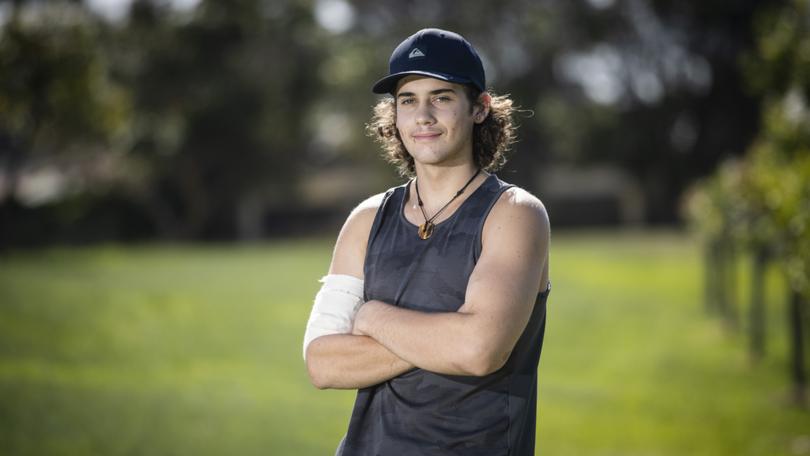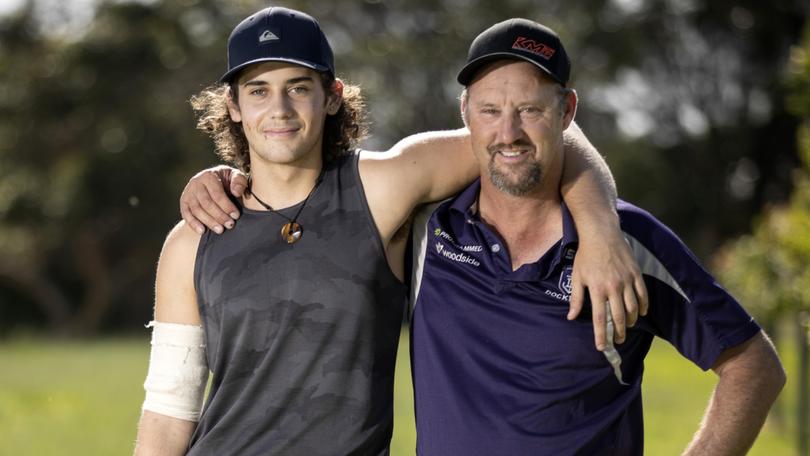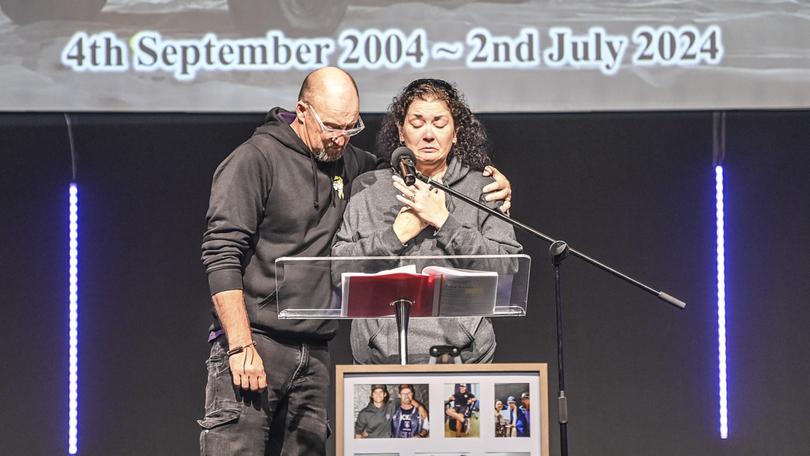Gift of life: Stem cell research is improving cancer survival rates but Aussies trail the world in donations

Levi Tracy was just 19 years old when he died waiting for a perfect match.
Ten years after beating lymphoma at just seven years old, he once again found himself facing a fight against cancer — this time it was Acute Myeloid Leukaemia (AML) — a condition caused by the very chemotherapy that saved his life the first time around.
And while the fight began again, the battleground had changed.
Sign up to The Nightly's newsletters.
Get the first look at the digital newspaper, curated daily stories and breaking headlines delivered to your inbox.
By continuing you agree to our Terms and Privacy Policy.This time doctors had a new weapon in their arsenal. Stem cells.
Just 159,000 people are listed on the Australian Bone Marrow Donor Registry (ABMDR) — the equivalent of about 0.6 per cent of the population.
But what many people might not know is that bone marrow isn’t the main form of donation that people on the register are giving to those in need.
Since 2000, bone marrow donations have seen a steady decline in favour of stem cell, or peripheral blood stem cell (PBSC), donations.
No longer are the majority of Australian donors undergoing general anaesthetic and surgery to donate vital products.
These days donations are done through a process called apheresis, which is similar to donating plasma, and donors can usually return to work the next day.
Levi’s father Mark Tracy is deeply passionate about stem cell donation after losing his son to AML in July — a condition around 900 people are diagnosed with each year nationally.
Sadly, there were no Australian donors on the register who matched Levi’s genetic profile.
With time running out, an overseas stem cell donor who was a 78-80 per cent match for Levi was finally found. It wasn’t perfect — but it would have to do.

“It was a hard road the first time, we had lots of complications leading up to it (and) we only just got him there a week or so before transplant,” Mr Tracy said.
“We later learned when he relapsed, what had actually happened was the cells were dormant.
“They didn’t show up, but they weren’t dead.”
Mr Tracy said Levi required a second stem cell transplant, this time his brother stepped up to the plate.
“We didn’t have time for a search, and his brother was less of a match than the previous donor but was related,” he said.
“He had a second stem cell transplant and he was tracking along beautifully, until he picked up a lung infection and it all went horribly south very, very quickly.”
Just 26 bone marrow donations were used to treat Australian patients last year, while more than 350 people received stem cell donations.
On the flipside, the register gets queries for about 1200 Australian patients each year.
Not every patient needs, or goes through with a donation — sometimes doctors make inquiries as part of a raft of possible solutions.
Other times it is too late, but experts say it’s hard to quantify that breakdown because of the complexities in collecting the data.
By the end of this year, the ABMDR will have undergone an important facelift — bringing it into line with current demand.
The new-look service will be known as Stem Cell Donors Australia.
While currently in Australia would-be donors need to attend a blood donation centre to join the list, The ABMDR is desperately lobbying to move to a cheek-swab model.
Chief Executive Officer Lisa Smith said that’s because while about 6000 donors were joining the list each year via the Australian Red Cross Lifeblood service, it simply wasn’t enough.
“Australia needs to be looking to recruit about 25,000 donors a year (and) really the only way they get that is through cheek swabs,” Ms Smith said.
“That’s just a simple way, you post it to people’s home… They swab their cheeks, send it back and they’re done.”
In 2019, the ABMDR ran a pilot program of mail-out cheek swabs, recruiting 5000 new donors.
Government funding extended the program in 2020-21, leading to another 6000 recruits.
But that funding dried up, and Ms Smith says the registry has since been using what minimal available funds it has to privately run a mail-out cheek swab program via Strength to Give.
About 85 per cent of Australian patients who receive a stem cell transplant through the ABMDR are being treated with international donations like Levi.
Many of them come from places like Germany — which has 26 registered donor services and a thriving donor list of more than 10 million people.
German National Bone Marrow Donor Registry ZKRD Chief Medical Officer Dr Joannis Mytilineos attributed the number of donors to the “general attitude of altruism” in the country.
“The rates of availability of German donors, even nowadays, is still significantly higher than that of other countries,” Dr Mytilineos said.
“That is magic, you know, the idea that there is someone, somewhere in the world who happens to have his genetic sibling in Germany.”
While German services were initially concerned about the quality of results moving to a cheek swab model, Dr Mytilineos said those concerns had long died down.
He said about 95 per cent of the country’s donors were now recruited via swabs.
“The issue of swabs versus blood wasn’t an easy decision in Germany too,” he said.
“One of the big donor centres in Germany started with the swabs quite early, whereas all the other donor centres were very resistant.
“It is much easier to have the swabs because you don’t really need to have somebody who is trained in blood taking (and) the discussion about the quality, in my opinion, after all these years now has settled.”
While Germany has a number of local processing facilities, there are currently no labs in Australia that can process cheek swabs, and all of them need to be sent internationally.
Ms Smith said she was agnostic about where the swabs were processed, but stressed that they just needed to be tested “reliably, quickly and cheaply”.
In 2021 the Federal Government published its Medical Research Future Fund Stem Cell Therapies Mission, which dedicated $150 million over nine years to support research into potential stem cell medicines.
In comparison, $4.2 million of revenue raised by the ABMDR itself as part of its Cord Blood Export Revenue (CBER) fund was released to the ABMDR earlier this year upon agreement by State and Federal Governments. It follows the release of $1 million of the funding in February 2023.
Just $1 million of the funding released this year is dedicated to helping the register drive donor recruitment via cheek swabs, and all up the funding since February last year has allowed for the recruitment of 2700 cheek swab donors.
Those CBER funds are part of more than $12 million raised through the program that the service has previously been unable to access due to the money being tied up between the different states and territories.

Federal Health Minister Mark Butler told The Nightly that was part of the issue, but said it “wasn’t clear why Australia had moved so slowly” to introduce cheek swabs compared to other countries.
“We know that cheek swabs are an effective and very economical way of bringing additional donors to the registry and giving people a better chance at life,” Mr Butler said.
“Used across the world, this is not a system that has yet been introduced in Australia.
“Part of the problem seems to be that no single government between the Commonwealth and the states and territories has sole responsibility or sole authority to make sure that Australia keeps pace with the rest of the world and with these advances in technology.
“This is just not good enough, it is currently denying patients in Australia the best chance to access this life-saving technology.”

Despite his heartache, Mr Tracy said he felt lucky to have shared 19 beautiful years with the son he affectionately nicknamed ‘Tiger’.
“I can tell you from spending time on the (Children’s cancer) ward we’re the lucky ones,” he said.
“My family were lucky.
“We saw children of all ages not make it out of that ward (and) we got 12 more beautiful years.
“And yet our story ends badly.”
However, Mr Tracy said it was imperative to fast-track newer and better treatments utilising stem cell technology, adding children’s cancers needed to be of the highest priority.
“If you think about yourself and what you see in the media and all the awareness around breast cancer and prostate cancer, how much do you see about children’s cancer,” he asked.
“It’s too confronting.
“We’ve got to get an end to this, there are better treatments on the horizon, and we need to push the awareness.
“A lot of people see adults get cancer, and while they don’t want to lose them, when they lose them they go, ‘Mum’s had a good life and she’s done this and she’s done that’, (but) kids haven’t had a crack.”
With technology constantly evolving in the space, there are new hopes that mismatched donors will soon be used more predominantly in treatments.
Monash University Professor David Curtis said new methods of preventing graft-versus-host-disease meant donors which would never have been considered 10 years ago can now be used more safely.
“There has been an explosion of the use of half-matched relatives, which appear to be almost as good as a fully matched donor,” Prof Curtis said.
“The use of half-matched relatives became even more popular when COVID hit because it became very hard to get fully matched unrelated donors from overseas, which is the most common source of these donors.
“Using relatives rather than unrelated donors is also much cheaper for the community.”
Prof Curtis said large, randomised trials were currently being undertaken to assess the effectiveness, but said results were still about five years away.
Ms Smith said the use of mismatched donors would only further justify the need to urgently recruit donors.
“Mismatching means that patients who have historically missed out, more likely to find a donor,” she said.
“But other factors then become more important, like age, and the Australian registry is still far too small to be able to meet that demand.
“It’s further justification as to why we need to recruit donors urgently, because otherwise that the 85 per cent of patients that haven’t gone overseas will only increase under a mismatch model.
“But on the upside, yes, it means a fewer patients will miss out on a donor.”
To join the register, Australian residents can register for a cheek swab kit at strengthtogive.org.au, or through a donation at your nearest Red Cross Lifeblood centre.
